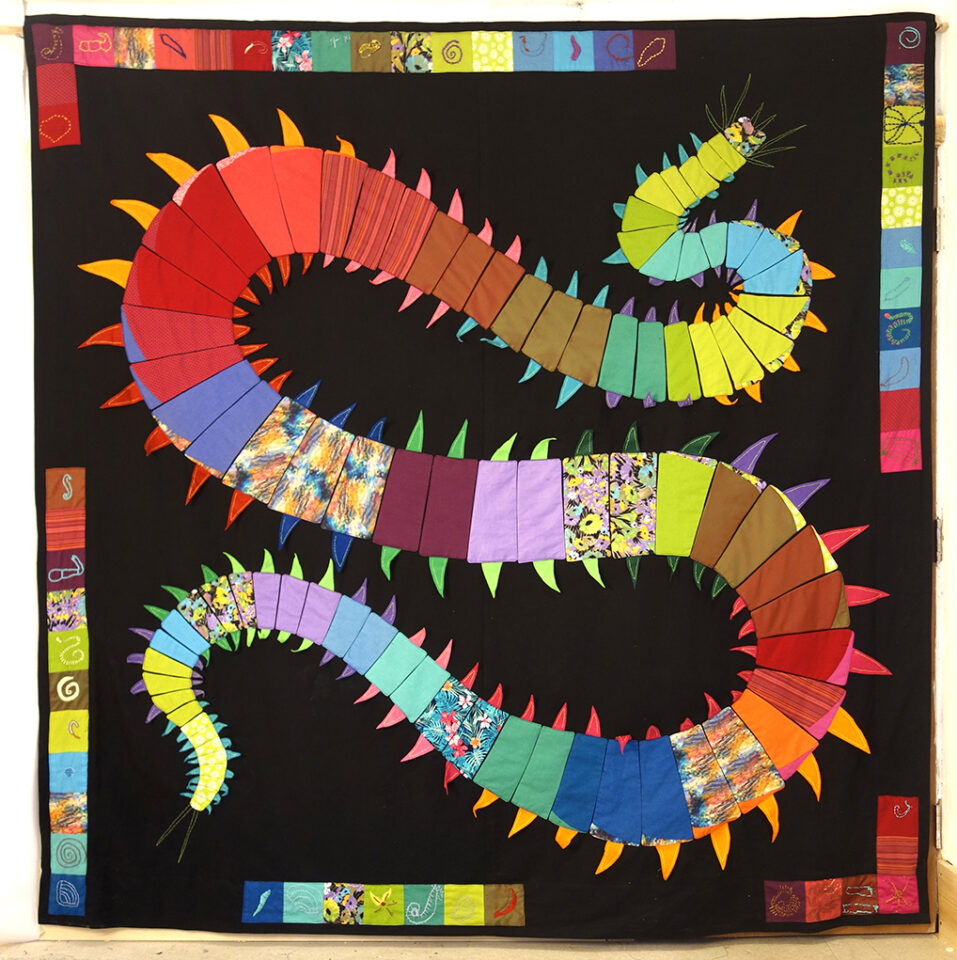SeaBed
SeaBed is a bedspread about the bed of the sea. It is a collaboration between scientists, refugees and artists and was made in Exeter entirely from salvaged and donated fabric.
This worm-made-of-rags depicts the ragworm, Hediste diversicolor, a common UK species of benthic worm. It lives in the mud under the sea and is an important species in marine ecology.
The border illustrations show many other species of benthic invertebrate, which are being studied by scientists from The University of Exeter as part of the Convex Seascape Survey. Their research is looking at how these benthic invertebrates cycle nutrients and store carbon, and how they may affect climate change. The Convex Seascape Survey is a five-year, pioneering global research project that will generate the critical data and insight on how to manage the ocean sustainably to maximise its carbon storage capabilities and Naomi has been working with them as artist in residence for the last year.
The embroidered pieces have been created here in Exeter by refugees and asylum-seekers, some of the people who are often most affected by climate change. People of different ages: young boys who had never sewn before, through grandmothers and mothers with their babies. They came from many different countries and spoke many languages, but with the help of images, we discussed these marine invertebrates and they embroidered them onto the fabric during several workshops.
The United Nations Convention on the Law of the Sea argues that the areas of the ocean floor that lie totally outside national sovereignty are “the shared heritage of humanity” and is intended to guarantee that the environment is protected. Through collaboration and co-making, ‘Sea Bed’ highlights this understanding and the fragility of the undersea ecosystem. By hand forming the benthic ecosystem in sections, a human community recreates an underwater community, and we can learn more about ‘the world in our hands’. Sustainable methods and materials not only minimise the carbon footprint of the artwork, but demonstrate the possibilities we have of making active choices in our lives to protect and conserve the ocean.
SeaBed was commissioned by Exeter City Council as part of Exeter’s Cultural Compact funded by Arts Council England. Naomi is extremely grateful to Exeter Culture, Refugee Support Devon, Devon Ukrainian Association, Devon Development Education (DDE), Scrapstore, Princesshay, Maketank, St Thomas Freecycle, Exeter Quilters, ExeterMarine, The Convex Seascape Survey, all those who helped and gave advice, and all the participants:
Alla, Amina, Tehmina, Florence, Ramatu, Isatu, Yohebeth, Angel, Rabi, Gony, Hirasami, Ledion, Mudira, Jensy, Nadia, Anila, Mabel, Diana, Olya, Ross, Stiven, Ivana, Raya, Zahra, Arsen, Salgai, Suno, Ansh, Adi, Katherine, Hassim and Daniel.
For more information about the work and the research, see
https://www.youtube.com/@ConvexSeascapeSurvey_
Ragworms:
Hediste diversicolor is one of the commonest intertidal polychaetes in the UK.
Adults may reach 6-12cm in length and have between 90-120 chaetae-bearing segments, each with a pair of limbs called parapodia, which have dorsal and ventral chaetae and are used for crawling and swimming. They can regrow their bodies if broken off, as each segment contains all the main constituents of the main ‘organs’.
Ragworms spend their lives in burrows in benthic mud, taking nutrients from their surroundings in various ways. They have pair of hard pincer-like jaws which are used to grab living prey, carrion and plant material. Sometimes they leave their holes completely to hunt for food on the surface of the mud and under rocks. They produce mucous which helps gather food, and has been shown to stabilise the sediment, much like tree-roots in soil.
When they reproduce, both sexes turn green. The pigment is caused by the breakdown of their blood as they produce eggs and sperm.
When the female is ready, the couple don’t meet, the male releases his sperm outside the entrance and she sucks it inside her burrow. He then dies, and her body ruptures, releasing thousands of fertilised eggs. She will still manage to oxygenate the burrow by moving around until her larvae hatch and she, too, dies.
Hediste diversicolor is widely distributed throughout north-west Europe on the Baltic Sea, North Sea and along Atlantic coasts to the Mediterranean.








